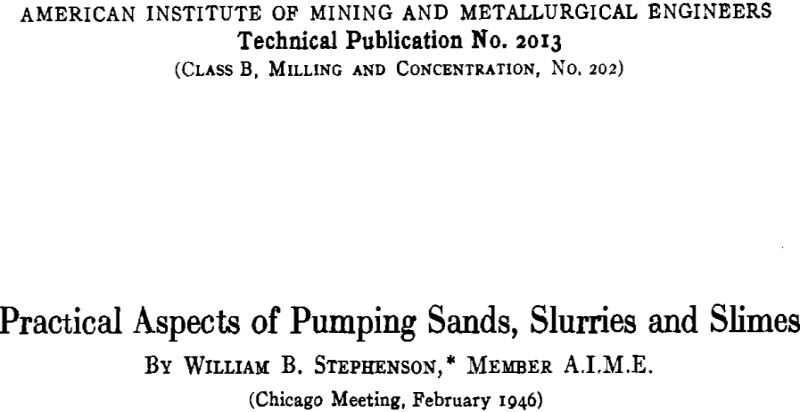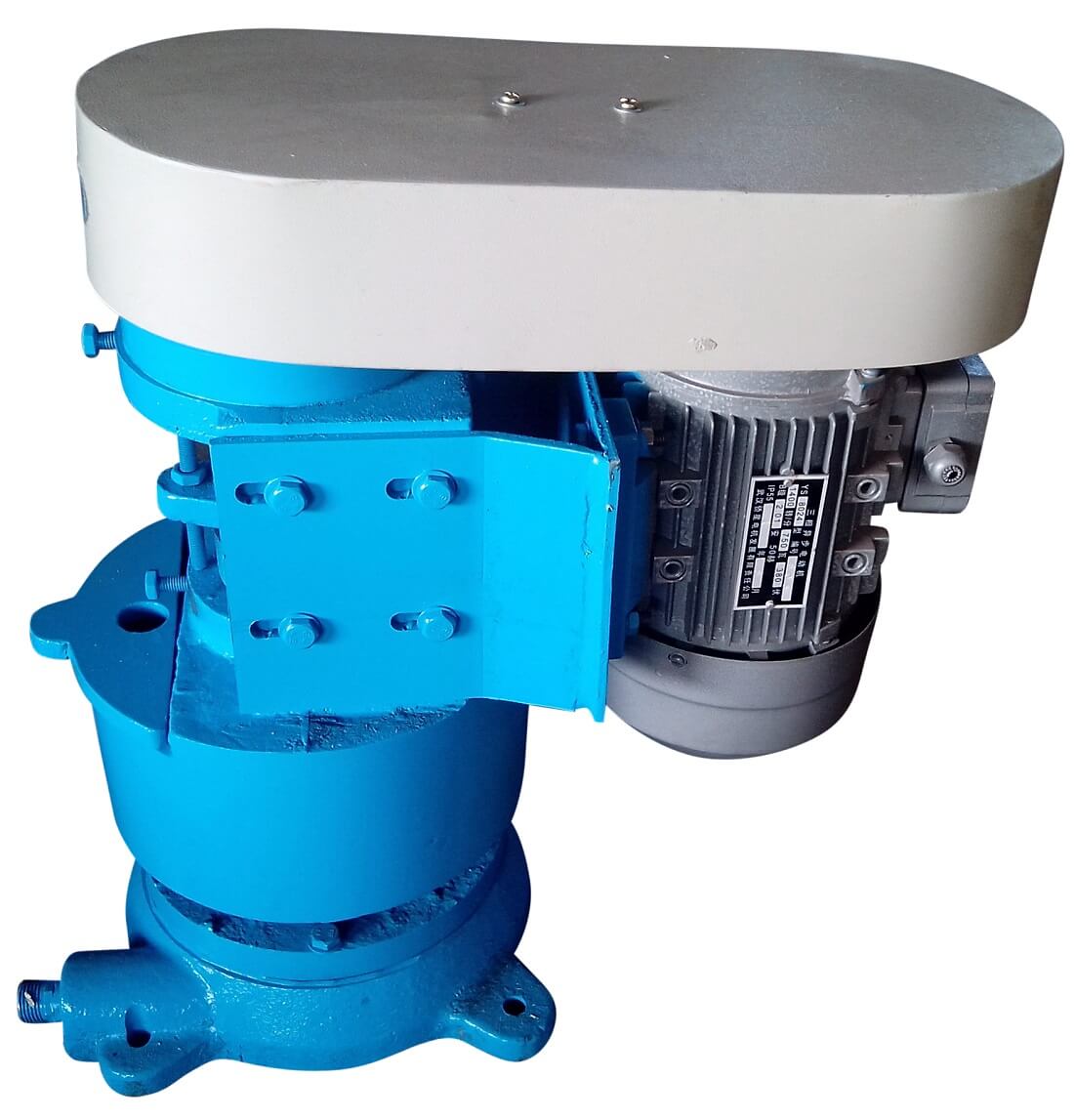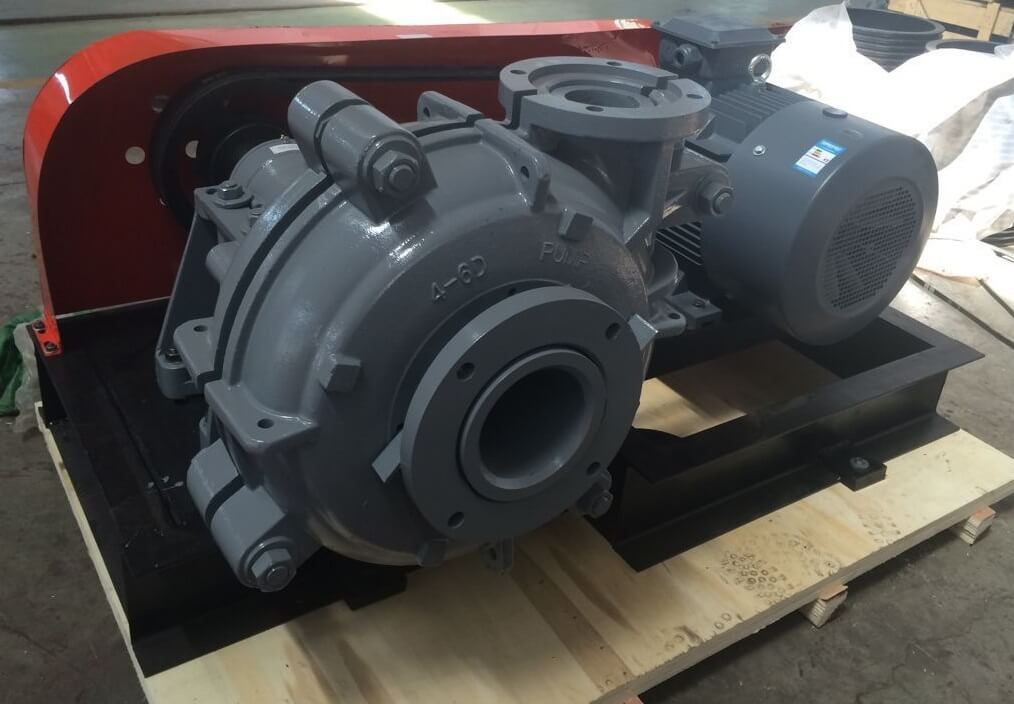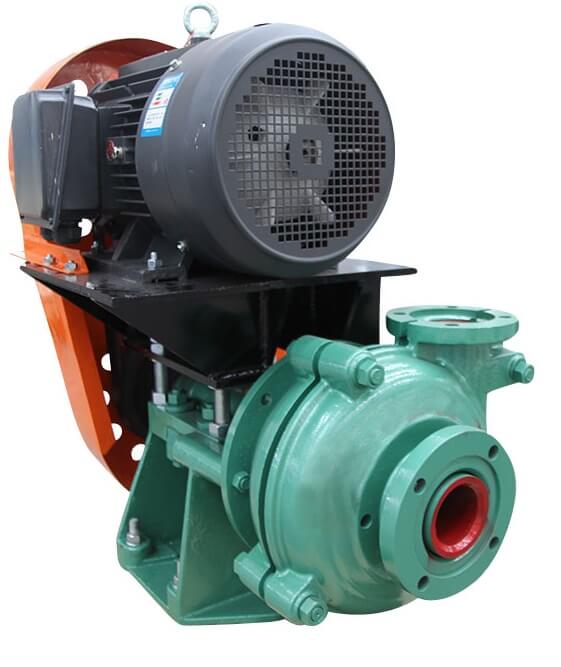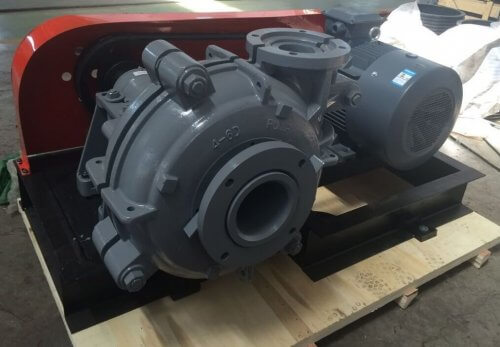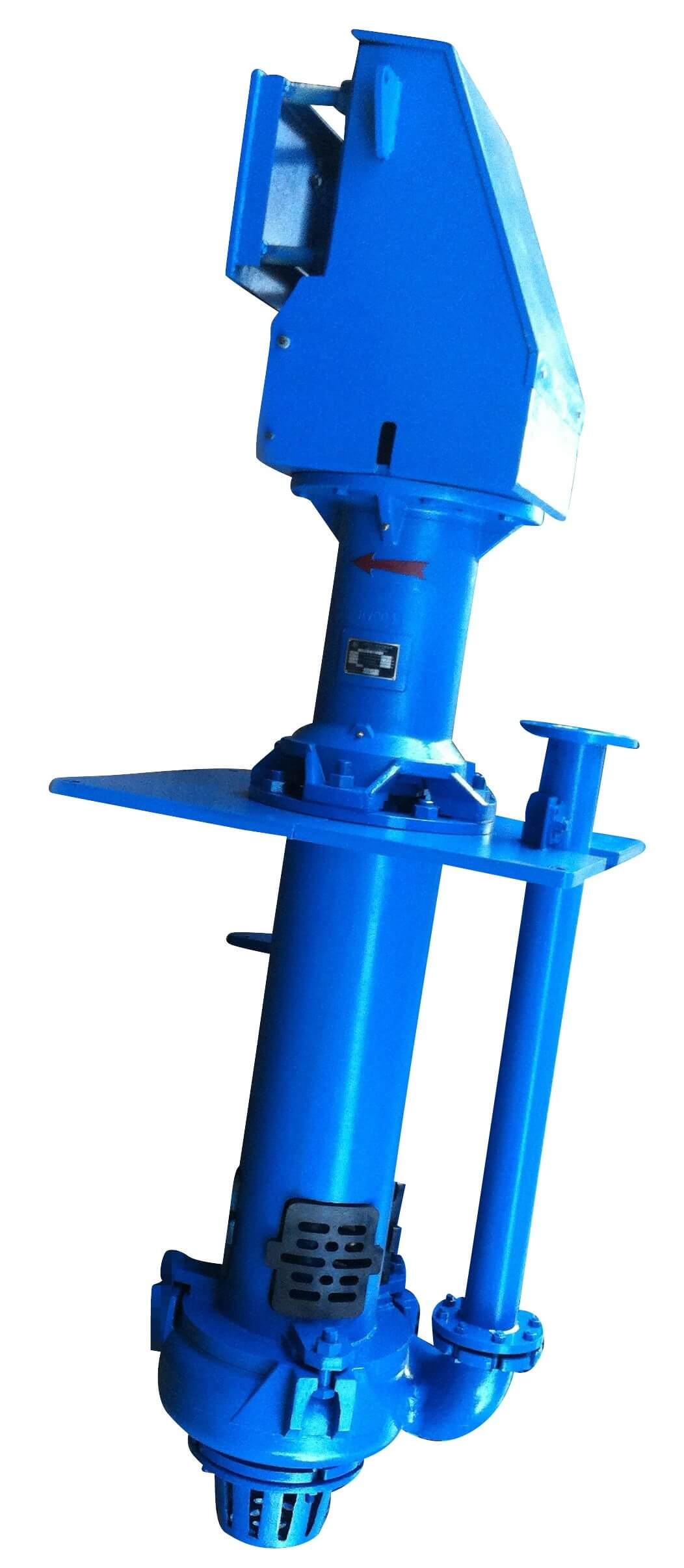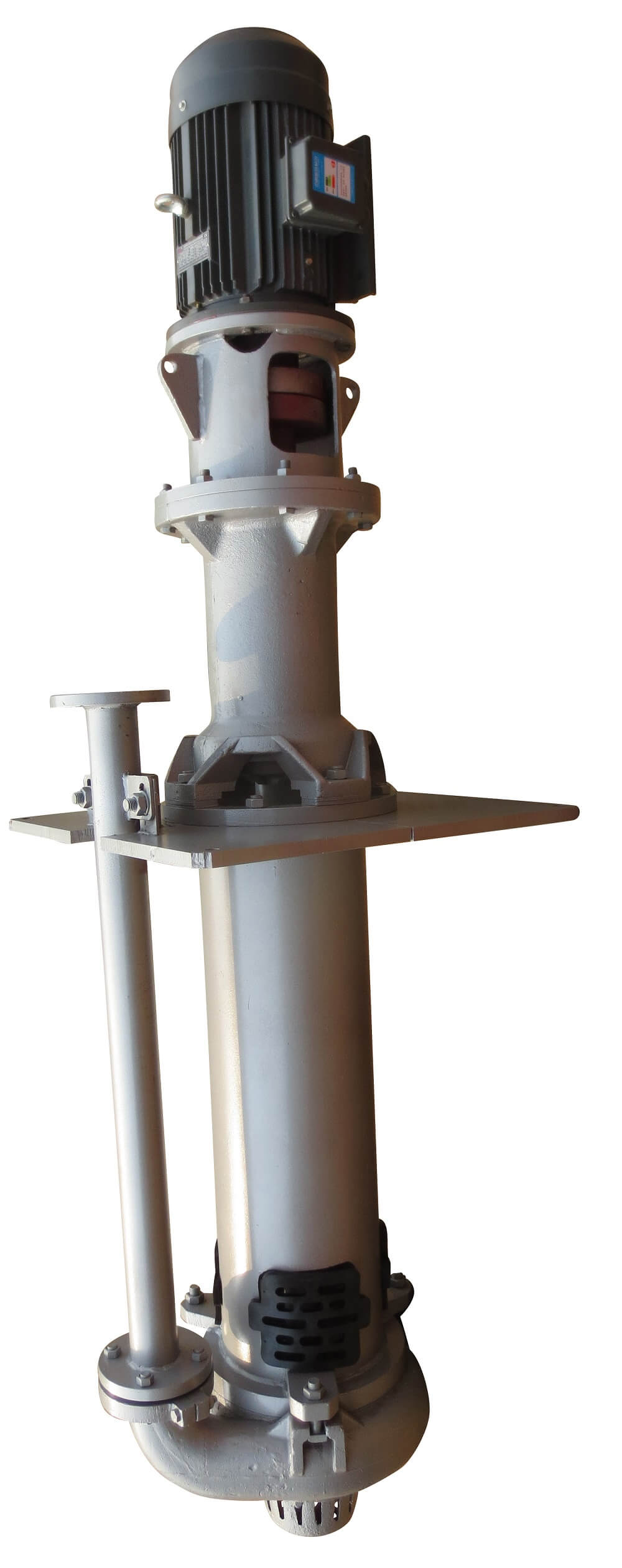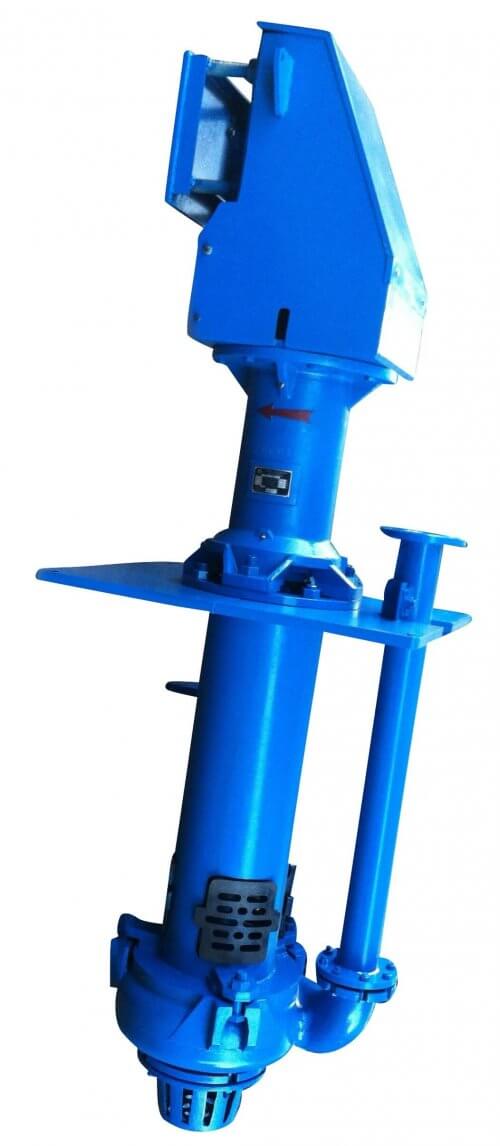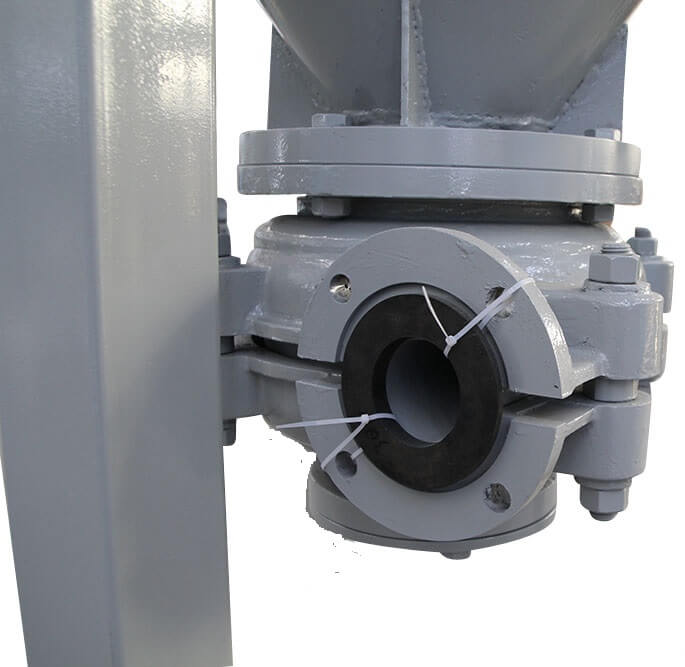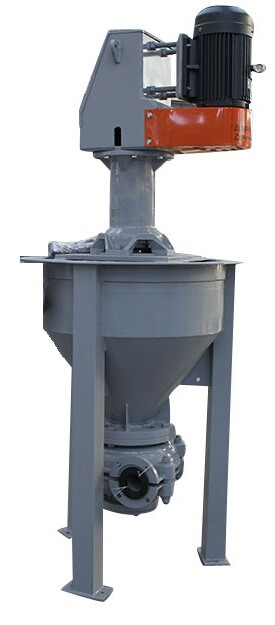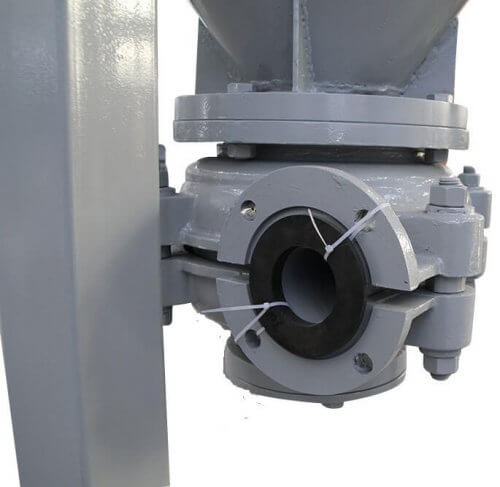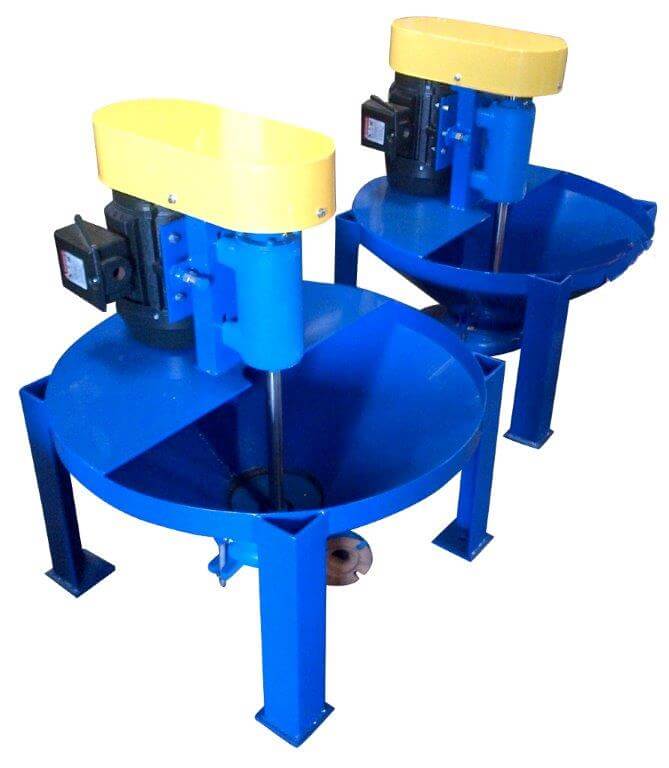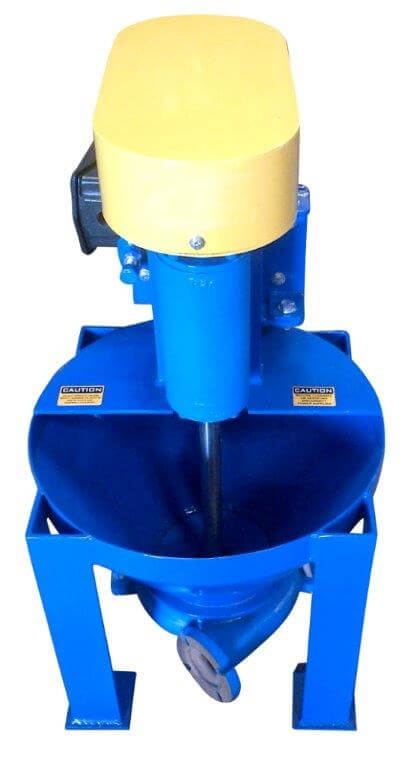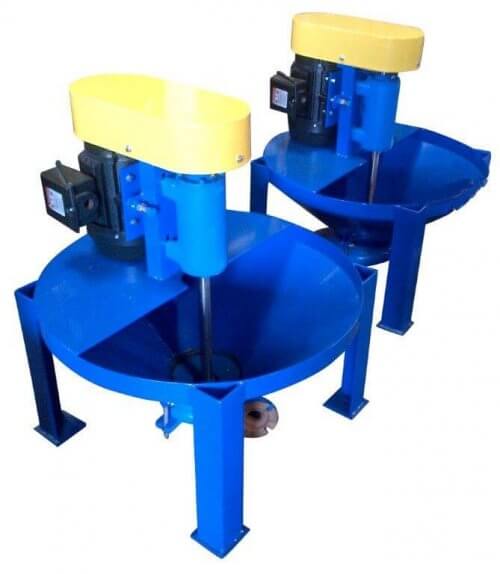Showing all 6 results
Practical Aspects of Pumping Sands Slurries and Slimes
In the pumping of sands, slurries and slimes, practices developed over the years are the real keystones of successful operation. These practices are necessarily based on modifications of familiar theories. Practical methods used in the solution of problems involving the pumping of mate¬rials are set forth in the following discussion.
Basic Requirements
To pump sands and slurries economically, a few basic requirements must be met by the pumping system as a whole.
A pipe-line velocity must be established that will move the fluid mixture throughout the entire system without any possibility of the solids settling out. To accomplish this, the velocity of flow must be slightly in excess of the critical velocity of the mixture. The critical velocity of a mixture varies from 3 ft. per sec. to 18 ft. per sec., depending on the screen analysis, concentration, and specific gravity of the solids in the mixture.
Most tailings are pumped at a minimum velocity of 4 ft. per sec. if they include slimes, whereas the pipe lines of sand and gravel dredges require velocities as high as 18 ft. per second.
A number of articles have been written on the determination of the minimum velocities required to maintain solids in suspension. Studies have also been made on the friction and pumping heads developed when handling solids in suspension.
Our experience so far has shown that, within the normal operating limits of a pumping system, the friction factor follows more nearly the basis described by Howard, who says, among his conclusions: “values of / (friction factor) will decrease with an increase in velocity.” This conclusion is borne out by our actual experience. When the velocity in a pipe line is not sufficient to keep the solids in suspension, the total friction head is greater than when the velocity is increased to a point where the solids are in suspension. A slight increase in the volume of feed to the pump and a slight increase in the pump speed are usually all that is necessary to put the system in balance.
Maintaining Constant Volume
Within reasonable limits, the volume of mixture to be handled through a pipe line should be held constant, so that the required velocity will be provided at all times. There are several ways in which this can be accomplished. The commonest is to provide a sump of sufficient capacity to take care of slight surges in the volume of mixture being fed to the pumping system. This sump, however, should not be as large as a settling chamber. The use of a float-controlled, fresh-water make-up valve in a sump will guarantee a constant volume. Where variations in volume are slight, introducing fresh water to maintain constant volume will have little effect on the density of the mixture being pumped.
When mill tailings are pumped, addition of mill waste water to maintain constant
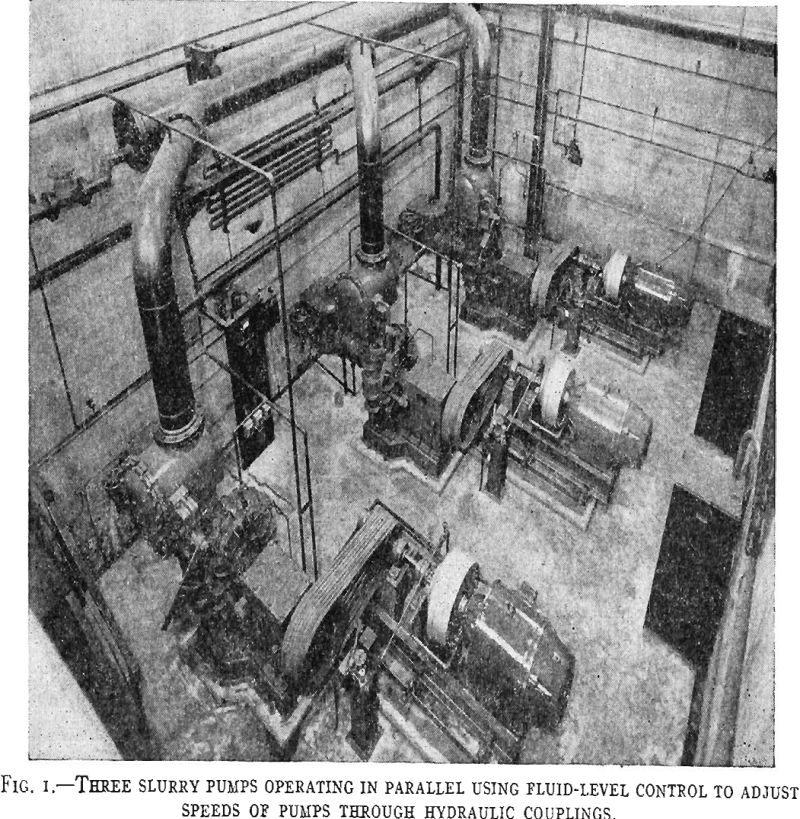
volume satisfies the pumping problem and disposes of the waste water. Sometimes the flowsheet calls for the settling of the tailings and the return of the “clear” water to the mill circuit. Using some of this water for make-up purposes is not objectionable.
Often the quantity of fluid to be pumped will vary within certain predetermined limits, hence the pipe line should be of a size that will permit the velocity of flow at the lowest volume limit to be maintained above the critical point. For proper operation of the pumps under such conditions, the speed of the pump should be adjusted to meet the volume condition as it changes.
For changing the speed of the pump while the pumping system is in operation, there are numerous possible arrangements of auxiliary equipment to suit each specific problem. If manpower is available at all times, manual control, through the use of drum controllers and wound-rotor motors direct connected to the pumps, or connected through V-belts to the pumps, is the most flexible. A speed range of 50 per cent can be secured with such equipment.
Slightly less expensive equipment can be installed, involving V-belt drives of the type that permits changing the pitch diameters of one or both sheaves while the unit is in motion. With this arrangement, however, pump-speed variations are limited to 20 to 30 per cent, depending on whether one or two sheaves are adjustable.
With additional expense, automatic change in pump speed can be accomplished, and the service of a pump operator dispensed with. Automatic control equipment can be adapted to the two arrangements described, and hydraulic and magnetic couplings actuated by changes in the fluid level in the sump can be used (Fig. 1).
Determination of Flow-Line Head
Determination of the total dynamic head against which the pump will have to operate is of prime importance in all sand and slurry pumping. In nine cases out of ten where trouble has been reported from the field, it has been found that the trouble has not been caused by the pump but by the conditions under which it has been required to operate. Usually the total dynamic head has not been figured properly.
The total dynamic head is the total of the static head, the friction head, and the suction head. If the pump is to operate with a “flooded” suction and there is sufficient height to the liquid level above the centerline of the pump, the suction head is a negative figure.
The static head can usually be determined accurately, as it is simply the vertical height of the column of liquid to be handled and is normally the difference in elevation between the fluid level on the suction side of the pump and the point of discharge. The exception to this rule is the case involving a discharge line of which the profile is such that the fall between any point in the line and its discharge end is greater than the pipe-line friction between those two points.
Friction head is based on the resistance to flow encountered by a given volume passing through a pipe line. The length of the line must be known and the number of elbows, valves, and so forth, must be taken into consideration in arriving at the total equivalent length.
Williams and Hazen have established friction losses in various sizes of pipe. For each type of pipe a coefficient has been developed to represent the relative condition of the pipe—new, old, rough or smooth.
In the normal calculation of friction losses in an ordinary water pipe line, the loss per hundred feet of pipe is usually taken from tables that use a coefficient of C = 100. This coefficient represents the friction loss in a 15-year-old pipe.
Experience has proved that abrasive material in water being pumped through metal pipes at velocities high enough to keep the solids in suspension scours the inside of the pipe, so that the resistance to flow develops friction losses almost equal to those appearing in the tables where the coefficient is C = 140. This friction loss corresponds to that of new, smooth pipe.
Thus, suppose a friction head is figured on the basis of C = 100, for a given volume through a given size of pipe, and a pump speed is selected to overcome that head; if the friction head is C = 140, or approximately 0.54 as much as was figured, the pump will move a proportionately greater volume of mixture at the same speed. Consequently, it will “overpump,” with harmful results to the wearing parts, and will also usually develop a surging discharge and impose an undue and harmful load on the motor. Fig. 2 illustrates what can happen if the proper friction factor is not used.
The example cited is based on the following assumed conditions: There are 1600 gal. per min. of mixture to be handled through 500 ft. of 8-in. pipe with 40 ft. of static discharge head. The suction is flooded, and the indicated entrance losses are assumed.
On the basis of C = 100, for 500 ft. of 8-in. pipe at 7.0 ft. per 100: friction head = 35.0 ft.; static head = 40.0 ft.; entrance loss = 5.0 ft.; total dynamic head = 80 feet.
On the basis of C = 140, for 500 ft. of 8-in. pipe at 3.78 ft. per 100: friction head = 19.0 ft.; static head, = 40.0 ft.; entrance loss, = 5.0 ft.; total dynamic head = 64.0 feet.
To handle 1600 gal. per min. against 80 ft. of head would require the pump, for
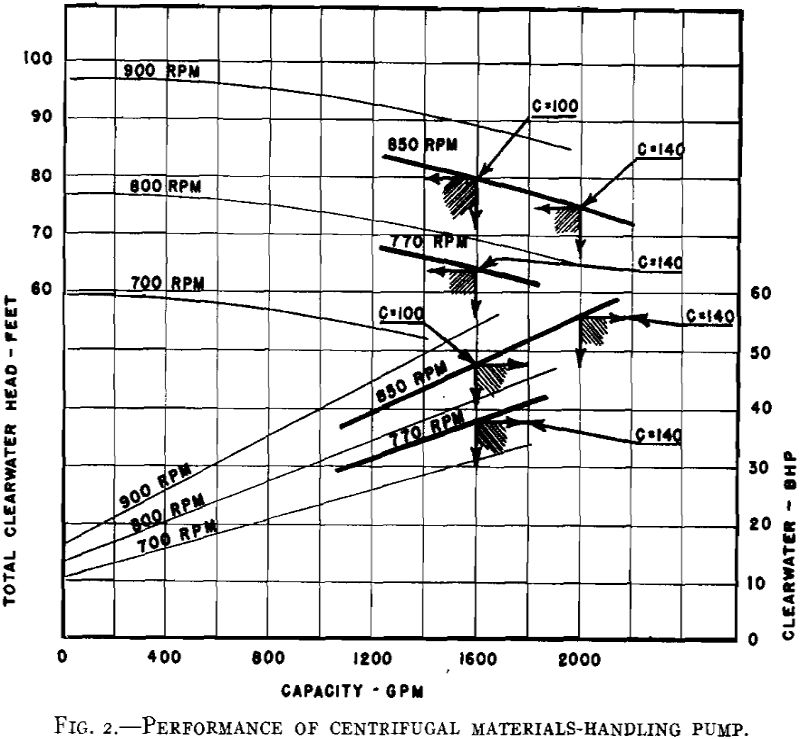
example, to operate at a speed of 850 r.p.m., and at that speed would take 48 clear-water brake horsepower.
On the other hand, to handle 1600 gal. per min. against 64 ft. of head would require this same pump to operate at 770 r.p.m. At this speed only 38 clear-water brake horsepower would be required.
If the pump were speeded to overcome the false head of 80 ft., and sufficient mixture was introduced to the sump, the pump would then handle 2000 gal. per min. against 75 ft. of head. The power would increase, however, to 56 clear-water brake horsepower. This probably would overload the motor.
Experience in actual operations supports the assumption that the additional frictional resistance to flow due to solid material in suspension varies closely in proportion to the specific gravity of the mixture. This is true within the limits of ordinary pulp densities and at velocities high enough to keep the solids in suspension. The static gauge pressure also increases as the specific gravity of the mixture increases. The increase in the kinetic energy in the heavier mixture handled by the pump requires an increase in the power input.
Practice supports the theory and experimentation of Fairbank and others; namely, that the power required to move a given volume of fluid having a given specific gravity is equal to the power required to move an equal volume of water multiplied by the specific gravity of the mixture involved.
There is no need to increase the speed of the pump if the solids to water ratio does not exceed 40 to 50 per cent by weight, and the line velocity is controlled to keep the solids in suspension.
As a result, for the average pumping job, the total dynamic head can be figured on a clear-water basis.
Other Losses
Entrance losses are usually overcome by virtue of the flooded suction condition under which most sand and slurry pumps operate. With the positive static head on the suction side working on the credit side, the velocity head, entrance loss and friction in the suction piping and fittings are working on the debit side. In a normal case, these three losses amount to about 3 ft. Therefore, the positive static head should not be less than 3 ft., and anything more than that will aid the over-all head condition.
Whenever possible, suction lift should be avoided in pumping sand and slurries. Adverse operating conditions, including the necessity of priming, are good reasons. Where a suction lift cannot be avoided, care must be taken to keep the suction line tight against air leakage, with no air pockets in the line. If valves and tees are turned on their sides, much of this can be avoided. Foot valves should never be used.
Sump Chambers
Considerable trouble in pumping systems is caused by improper sump design. Just any old feed box will not do for most conditions. The size of the sump will depend, of course, on the volume being handled, but the shape of the sump can be similar for all conditions. The sump should have sufficient capacity to take care of normal variations in feed without spilling over. The ideal sump should be cylindrical, and for a volume of from 400 to 800 gal. per min. should be about 3 ft. in diameter. The sump should be high enough to provide 4 ft. of liquid level above the centerline of the pump and then 12 to 18 in. higher to provide surge capacity.
The bottom of the sump should slope at not less than 450 from the horizontal on three sides toward the suction connection. An overflow connection at the top of the sump should be provided, in addition to a “well” for the adaptation of a float for float-controlled fresh-water make-up.
A vertical baffle should be installed in the upper part of the sump, to prevent a vortex from forming, and if the feed drops into the sump from a height sufficient to carry air down into the liquid in the sump a horizontal baffle or splash plate should be installed just above the normal liquid level.
In all sumps that are unattended, a low-level alarm should be installed, to guard against uncovering the suction of the pump. When a pump is carrying away the feed faster than the latter is coming into the sump, the level will be drawn down and air will be drawn into the pump. This tends to interrupt the flow, with a resultant drop in the velocity in the discharge line, and can be the cause of plugging of the line if the interruptions occur at more or less regularly extended intervals.
Pumping Froths
An exception to most of the rules is in the pumping of frothy mixtures. For these, there should be at least 6 ft. of liquid above the centerline of the pump suction. The pump suction should be as large as possible, to provide the lowest possible inlet velocity. The pump itself should be oversize, to permit low speed. If a 3-in. pump would normally be used for the quantity to be handled, a 6-in. pump should be installed, and advantage should be taken of the 6-in. inlet connection to run the pump at low speed. The discharge connection, however, should be reduced, to provide a velocity high enough to keep the solids in suspension in the discharge pipe line.
When permissible, a fine spray of water should be put across the feed to the sump, in an effort to break down the froth.
Pumping Equipment
So far, emphasis has been placed on the importance of proper design of the pumping system as a whole. The success of such a system, involving the pumping of sands, slimes, and slurries, lies in the proper selection of the pump itself. Improper selection and use of otherwise good equipment can result in high operating and maintenance costs.
There is a type of pump for each service. By virtue of design and the materials involved, a pump that is satisfactory for one service may not be satisfactory for another. In comparison with pumps used for clear-water service, materials-handling pumps are not efficient. Clear-water pumps are designed with close clearances, which stay that way throughout most of the life of the pump. Materials-handling pumps may be designed with close clearances but they do not stay that way very long, because of the short-circuiting of the abrasive-laden water through these clearances. Unless some protective principle is embodied in the design of the pump to prevent this short-circuiting, the clearances become enlarged and the efficiency drops off. When this happens, the volume handled also drops off and the pump must be speeded up, with an increase in power requirement.
In clear-water pumps, lubrication of the packing is accomplished by loosening the gland and permitting a small amount of water to leak out. This cannot be done in a materials-handling pump because the water thus permitted to leak out also would carry abrasives, with the result that the packing would become impregnated and soon the shaft or shaft sleeve would become scored and ruined. In a materials- handling pump, the design should provide for fresh water entering the gland from outside rather than from within the pump.
The wearing parts should be of the best material available for the particular work involved. Rubber, when properly compounded, will outlast any known metal when handling fine slurries and slimes but will go to pieces quickly if used in handling solids larger than 3/8 in. in size.
Manganese steel is excellent for handling large solids in sand and gravel pumping, because it work-hardens from the impact of the large pieces. If used in handling fine slurries and slimes, manganese steel will wear away quickly.
Many alloys are in service in materials- handling pumps, each of which is particularly well suited for a specific mixture. Actual practice has shown that usually the harder alloys are best as long as the material is not too brittle and subject to shock.
Materials-handling pumps, as far as we know, are always single-stage centrifugal pumps. Where particularly high heads are involved, it is often necessary to use two or more pumps in series rather than one pump at excessive speed. The wear on the parts is almost in direct proportion to the speed of the pump. When the selection of a suitable pump narrows down to one of two sizes, it is best to pick the size that provides the lowest vane-tip speed. It is far better to have two low- speed pumps in series than to pay the maintenance on one high-speed pump.
Operating Procedure
In all installations used for pumping solids in suspension, the equipment must be operated and maintained properly if the installation is to be economical.
A few simple rules should be followed to obtain the best results, some of which are worth stating here:
- Preliminary Inspection before Initial Starting up.—Many pumps cannot be rotated in a reverse direction, under power, without considerable damage to them. The rotation of the driving unit, therefore, should be checked before it is connected to the pump. The gland water should be turned on, to make sure that it is clear and at the proper pressure to ensure its flow into the pump under pressure rather than out of the gland, as in clear-water pumps.
- Rigidly Enforced Procedure in Starting up and Stopping of System.—The pumping system should be started up on clear water whenever practicable. Such a procedure will permit checking of all suction and discharge connections for leaks. The operator can also determine that the pipe line is clear, by seeing that the indicator of a gauge on the discharge reaches the proper, predetermined point. When the system appears to be in proper operation, the feed can be introduced.
For a normal shutdown, the procedure just described should be reversed. The feed should first be cut off, then the system permitted to run on clear water for a period of time sufficient to clear out the line. Then the pumps can be shut down and the gland water turned off.
Provision should be made for draining any materials-pumping system in the event of an emergency shutdown. Dump valves in the discharge pipe line just beyond a pump can be tied into the pump motor circuit electrically. In case of power failure these valves should open, permitting the system to drain. - Gland Water, Temperature of Bearings. During operation of the pumps, the glands should be checked to make sure that no abrasives are being short-circuited into them. The temperature of the bearings should be watched, especially in the early periods of operation. They should be lubricated in accordance with the manufacturer’s instructions.
- Liquid Level in Sump.—If no automatic equipment is provided to maintain a constant volume of feed to the pump, or if there is no automatic adjustment of the speed of the pump, extra care should be exercised by the operator to be sure that the pump is getting neither too much nor too little feed.
- Variations in Supply of Solids to Mixtures.—Normally, the concentration of solids in a mixture is pretty well controlled by the many steps followed in a flowsheet before the mixture reaches a sump. Where the solids are mixed with a fluid just prior to entering a sump, there should be some means of controlling the solids-liquid ratio. It is not recommended that mixing be accomplished in a sump—mixing should be done a short distance away and the fluid allowed to flow by gravity into the sump.
- Periodic Inspection and Overhaul.— Materials-handling pumps require maintenance. Periodic inspection soon develops a time cycle in which repairs can be made at regular intervals without the possibility of unexpected shutdowns except for unusual reasons.
Conclusions
- Velocities of solid-fluid mixtures in pipe lines must be maintained above the critical point in the discharge pipe line.
- Total dynamic heads must be figured accurately.
- Sump and pump design must be fitted to the particular problem at hand.
- Operating and maintenance procedures must be set up and adhered to.
- An installation embodying the foregoing principles is bound to be successful and economical.
